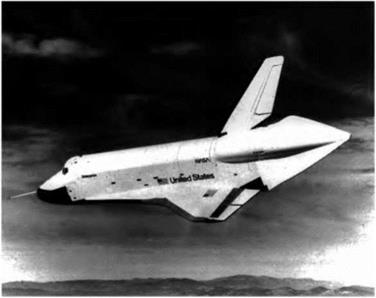Sub-orbital flight – the aeroplane – missile – satellite
Have you ever realised that the ‘lift’ required to keep an aeroplane in the air depends upon the direction in which it is travelling? – e. g. whether it is going with the earth or against it. In an earlier paragraph we worked out the centripetal force on a body of mass 1 kg sitting on the earth’s surface at the equator – sitting still, as it seems, but in fact behaving like a stone travelling at 1690km/h on the end of a string of 6370 km radius. The answer didn’t come to much – about 0.018 N – but the principle is of extreme importance.
The corresponding value for an aeroplane of mass 10190 kg is about 400 N, still not much perhaps, but none the less an appreciable and measurable quantity. It means that if the real force of gravity on the aeroplane is
|
|
Fig 13E The Space Shuttle (By courtesy of NASA)
100 000 N, it would appear to weigh only 99 600 N – in fact, of course, we would call this the weight, it is the force we would have to exert to lift it.
But it is a solemn thought, though none the less a fact, that if this aeroplane were to fly against the direction of the earth’s rotation, i. e. towards the west, at 1690 km/h, it would not require this centripetal force, and so would appear to weigh 100 000 N – and that is the lift the wings would have to provide. If, on the other hand, it flew towards the east at 1690km/h, its real speed would be 3380 km/h, and the centrifugal force would be, no, not 800 N but 4 X 400,
i. e. 1600 N (because the centripetal force depends on the square of the velocity), so the lift that the wings would have to provide would be 100 000 — 1600 = 98 400 N.
Similarly at a real speed of 6760km/h (5070 km/h eastwards) the centripetal force would be 6400 N, and the necessary lift 93 600 N. At 12 800 km/h (11 200 km/h eastwards), the corresponding figures would be 25 600 N and 74 400 N; and at 25 600 km/h, 102 400 N and minus 2400 N! At approximately 29 000 km/h the centripetal force is 100 000 N and the lift required nil.
What does it all mean? Well, the reader who has followed the arguments in this chapter will surely know what it means – simply that the aeroplane travelling at 29 000 km/h near the earth’s surface is travelling at the circular velocity, it doesn’t need any lift from the wings, it will stay up of its own accord, it is a satellite. Nor when these velocities are reached does it make all that difference (only 1600 km/h each way) whether it travels east or west.
What it will need is colossal thrust to equal the colossal drag, which in any case will cause it to frizzle up.
But what if it flies higher – and higher – and higher? The drag for the same real speed will be less, less thrust will be needed, the circular velocity required for no lift conditions will be less, even the real force of gravity upon it will be less; it won’t even create a sonic boom at ground level.
Can you answer these?
Now let us see what we know about this fascinating subject –
1. What is meant by escape velocity? What is its approximate value for the earth? Is it the same for the moon?
2. Is the escape velocity the same for a horizontal launch as for a vertical launch?
3. Distinguish between the perigee and the apogee in an elliptical orbit.
4. What is the particular significance of a satellite circling the earth at about 35 400 km from the centre of the earth?
5. What is the time of circular orbit of –
(a) a satellite very near the earth’s surface?
(b) a satellite 1600 km from the earth’s surface?
(c) the moon?
6. Under what conditions is the path of a satellite parabolic? hyperbolic? For solutions see Appendix 5.
For numerical examples on missiles and satellites see Appendix 3.












